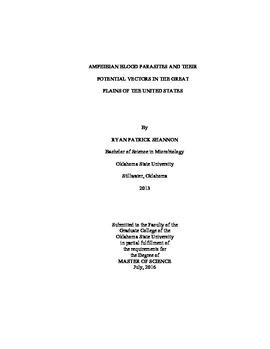| dc.description.abstract | Between May 2014 and August 2015, 200 larval, newly metamorphosed and adult amphibians from 5 families and 9 species were examined for blood protozoa, leeches and leech hematomas from five locations in north central Oklahoma. Of those, only adult bullfrogs (Lithobates catesbeianus) and newly metamorphosed and adult southern leopard frogs (Lithobates sphenocephalus) were infected with Hepatozoon and/or Trypanosoma spp. Six species/morphotypes of blood protozoans infected southern leopard frogs and bullfrogs and conformed to previous descriptions of (1) Hepatozoon catesbianae, (2) Trypanosoma ranarum, (3) T. schmidti, (4) T. loricatum, (5) T. rotatorium, and (6) T. chattoni. Because leeches or leech hematomas were never observed on any amphibians collected, I sampled for potential leech and dipteran vectors and examined tadpoles, newly metamorphosed and adult southern leopard frogs for blood infections from a single location. One species of turtle leech (Placobdella rugosa), and 2 species of mosquitoes that are known to feed on amphibians (Culex erraticus and Uranotaenia sapphirina), were collected as potential vectors. Blood protozoan prevalence and species richness increased as southern leopard frogs aged and became more terrestrial in their habitats, being 0 in tadpoles, 0.09 � 0.3 (9%) in newly metamorphosed frogs and 1.10 � 1.34 (52%) in adult frogs, suggesting that frogs acquired infections with blood protozoans in a terrestrial environment and potentially via dipteran vectors after metamorphosis. Sequencing of the 18s rRNA gene and phylogenetic analyses of the blood parasites in this study revealed that the trypanosome morphotypes are genetically distinct and the Oklahoma strain of H. catesbianae formed a polytomy with previous sequences of H. catesbianae and H. clamatae from Canada. Broader sampling of blood parasite species/morphotypes with additional genetic markers is necessary to resolve the phylogenetic relationships within these blood protozoans and to better support trypanosome species identifications. | |
